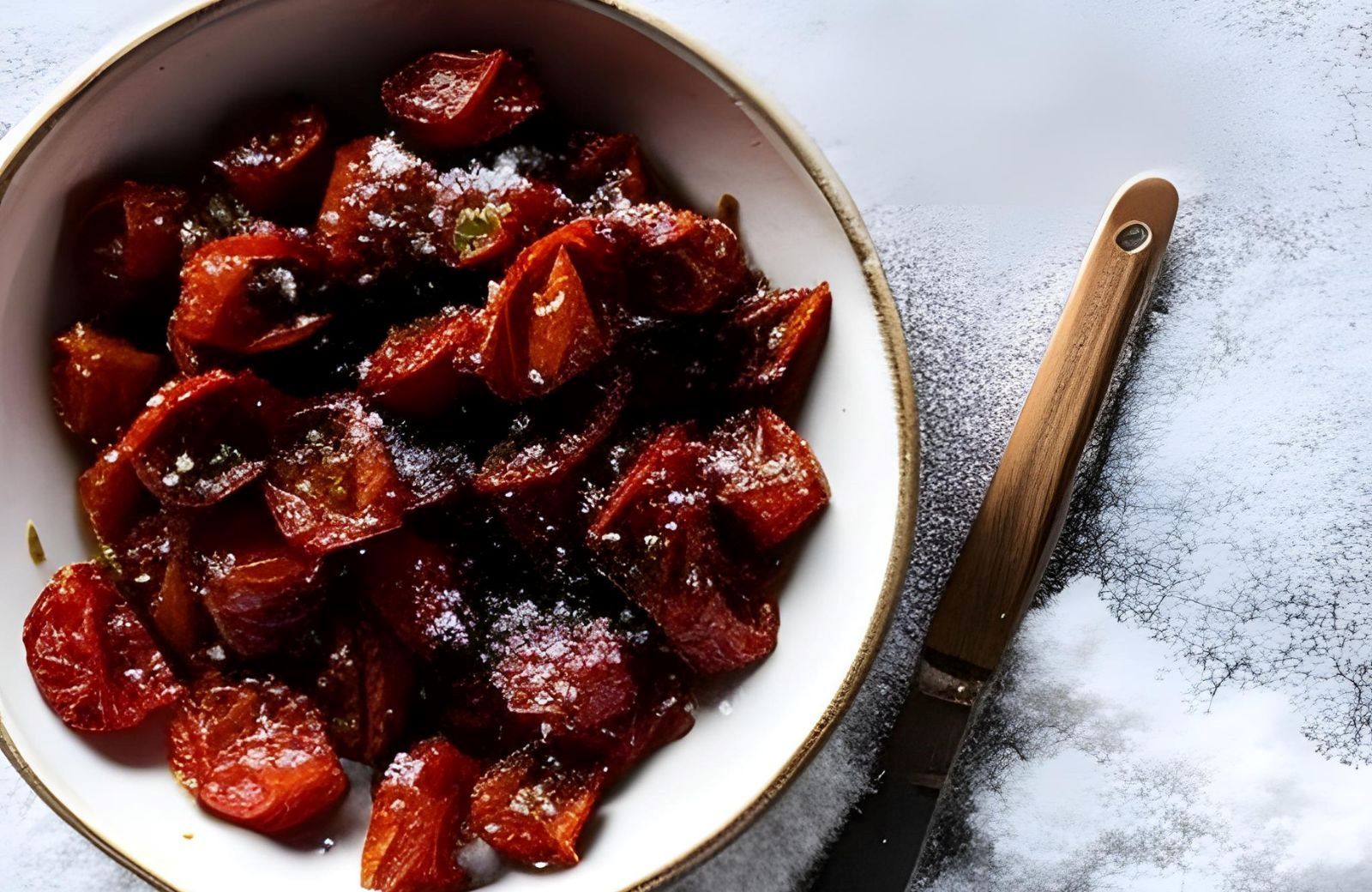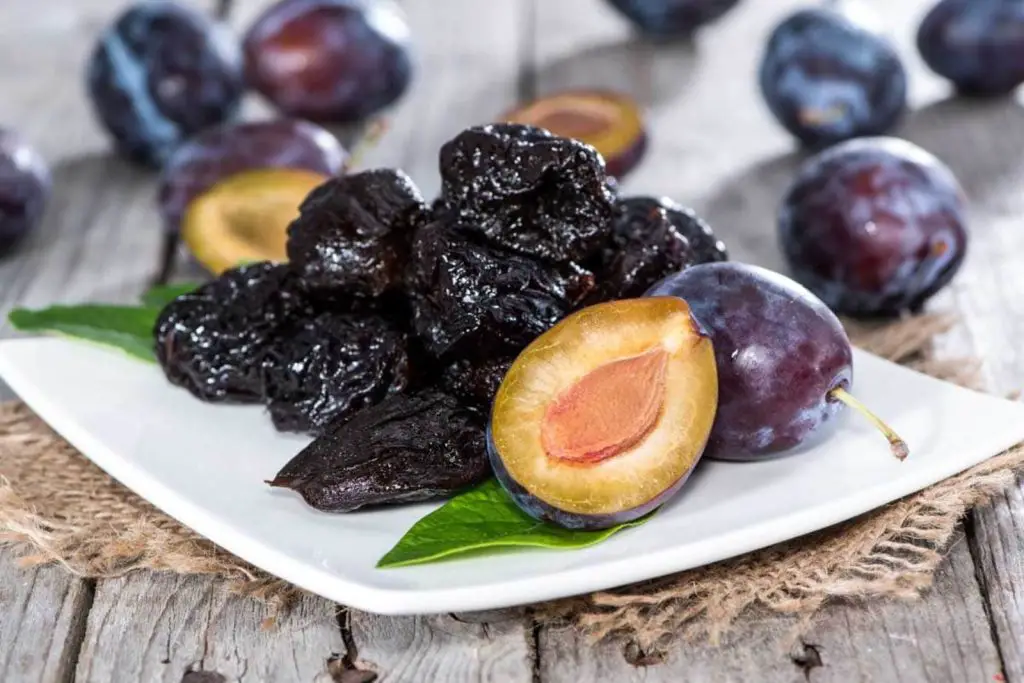
Toasted tomatoes are typically made by slicing tomatoes and then toasting them in an oven or on a grill until they are slightly charred and caramelized. This process enhances their natural sweetness and intensifies their flavor. Toasted tomatoes can be used in a variety of dishes, such as sandwiches, salads, and pasta. They can also be enjoyed on their own as a simple side dish or snack. Freezing roasted tomatoes is a great way to preserve their flavor and enjoy them all year round.
Here’s a simple guide on how to freeze roasted tomatoes:
- Step 1: First, preheat your oven to 400°F (200°C).
- Step 2: Wash the tomatoes and cut them in half.
- Step 3: Place the tomatoes cut-side up on a baking sheet.
- Step 4: Drizzle the tomatoes with olive oil.
- Step 5: Roast the tomatoes in the oven until they are slightly charred.
- Step 6: Let the roasted tomatoes cool completely.
- Step 7: Transfer the roasted tomatoes to a freezer bag.
- Step 8: Seal the container.
- Step 9: Label the container or bag with the date and contents.
Step 1: First, preheat your oven to 400°F (200°C).
Preheating the oven is an important step before roasting tomatoes or any food for that matter. Preheating the oven means heating it up to the desired temperature before placing the food inside, allowing for even cooking and better results.
In the case of roasting tomatoes, preheating the oven to 400°F (200°C) ensures that the tomatoes cook evenly and become soft and slightly charred. If the oven is not preheated, the tomatoes may not cook evenly, and the texture and flavor may be affected.
It’s important to note that ovens can vary, so it’s best to use an oven thermometer to ensure the correct temperature. Preheating the oven also helps to reduce cooking time and can help prevent food from sticking to the baking sheet or pan.
Step 2: Wash the tomatoes and cut them in half.
Washing the tomatoes before roasting them is an important step to remove any dirt or debris that may be present on the surface of the tomatoes. It’s important to wash them thoroughly under running water to ensure that any impurities are removed.
Cutting the tomatoes in half allows them to cook evenly and ensures that they are roasted all the way through. Removing the stem and seeds is optional, but it can help to improve the texture and flavor of the roasted tomatoes. The stem can be tough and difficult to eat, and the seeds can add a bitter taste to the tomatoes.
However, if you prefer to keep the stem and seeds, you can do so. It’s important to note that removing the seeds can also reduce the amount of liquid that is released during roasting, resulting in a firmer texture for the roasted tomatoes.
Step 3: Place the tomatoes cut-side up on a baking sheet.
By placing the tomatoes cut-side up, the heat from the oven is able to penetrate the flesh of the tomatoes, cooking them evenly and helping to develop a slightly charred and caramelized exterior. The parchment paper prevents the tomatoes from sticking to the baking sheet, which can make them difficult to remove and can affect their appearance.
It’s important to leave some space between the tomatoes on the baking sheet to ensure that they roast evenly and don’t stick together. If you don’t have parchment paper, you can also use aluminum foil or lightly grease the baking sheet with oil.
Step 4: Drizzle the tomatoes with olive oil.
Olive oil adds a rich and fruity flavor to the tomatoes while also helping them to caramelize and become slightly crispy on the outside. It also helps to prevent the tomatoes from drying out during roasting.
Salt and pepper are used to season the tomatoes and enhance their natural flavors. Salt helps to bring out the sweetness of the tomatoes, while pepper adds a slightly spicy kick that complements the sweetness of the tomatoes.
It’s important to note that the amount of olive oil, salt, and pepper used can vary depending on personal preference and the size and number of tomatoes being roasted. It’s always a good idea to start with a small amount of seasoning and adjust as needed to achieve the desired flavor.
Step 5: Roast the tomatoes in the oven until they are slightly charred.
Roasting the tomatoes at 400°F (200°C) for 25-30 minutes allows them to become soft and slightly charred, which intensifies their natural sweetness and gives them a more complex and robust flavor. The exact roasting time may vary depending on the size and variety of tomatoes being used, so it’s a good idea to keep an eye on them after about 20 minutes to avoid overcooking or burning them.
When the roasted tomatoes are done, they should be soft and tender, with a slightly caramelized exterior. They should be easy to pierce with a fork, and the skin should be slightly wrinkled. The amount of char on the tomatoes can also vary depending on personal preference. Some people prefer them more charred, while others prefer them less so.
After roasting, it’s important to let the tomatoes cool down before using them in your favorite recipes. This allows them to retain their flavor and texture.
Step 6: Let the roasted tomatoes cool completely.
When the tomatoes are removed from the oven, they are still hot and continue to cook, and if you try to handle them or use them immediately, they may become mushy or fall apart. Allowing them to cool down to room temperature allows them to firm up slightly and retain their shape and texture. It also allows the flavors to develop further and become more pronounced.
After cooling, the roasted tomatoes can be stored in an airtight container in the refrigerator for up to 5 days or frozen for longer storage. They can be used in a variety of recipes, such as sauces, soups, salads, sandwiches, and more.
Step 7: Transfer the roasted tomatoes to a freezer bag.
Using a freezer-safe container or a freezer bag helps to protect the roasted tomatoes from freezer burn, which can negatively affect their texture and flavor. It also makes it easy to store them in the freezer and retrieve them when you need them.
Before transferring the roasted tomatoes to a freezer-safe container or a freezer bag, it’s important to make sure that they have cooled down to room temperature. This helps to prevent moisture from building up inside the container or bag, which can also contribute to freezer burn.
When storing the roasted tomatoes in a freezer-safe container or bag, make sure to label them with the date and contents, so you can easily identify them when you need them. Store the roasted tomatoes in the freezer for up to 6 months for best quality.
Step 8: Seal the container.
Sealing the container or bag and removing as much air as possible is a crucial step in the process of freezing roasted tomatoes.
Air exposure in the freezer can lead to freezer burn and negatively affect the texture and flavor of the tomatoes. Freezer burn occurs when the moisture in the food evaporates and the surface dries out, which leads to the formation of ice crystals. This causes the food to become dry, tough, and tasteless.
By removing as much air as possible from the container or bag, you can help prevent freezer burn and prolong the quality and freshness of the roasted tomatoes. Once the container or bag is sealed, make sure to label it with the date and contents so that you can easily identify it later. Finally, place the container or bag in the freezer and freeze for up to 6 months for best quality.
What are the best-recommended bags and containers for freezing roasted tomatoes?
Here are some of the best-recommended options:
- Freezer bags: Zip-top freezer bags are a great option for freezing roasted tomatoes. Make sure to choose heavy-duty freezer bags that are specifically designed for freezer use, as they are thicker and less likely to tear.
- Glass containers: Glass containers with airtight lids are another great option for freezing roasted tomatoes. They are durable, reusable, and can be easily labeled.
- Plastic containers: Plastic containers that are labeled as “freezer-safe” can also be used for freezing roasted tomatoes. They are lightweight, stackable, and can be easily sealed.
- Mason jars: Mason jars are a popular choice for freezing roasted tomatoes. They are airtight, reusable, and can be easily labeled. Just make sure to leave some space at the top of the jar to allow for expansion during freezing.
Step 9: Label the container or bag with the date and contents.
This makes it easy to identify the contents and keep track of how long they have been stored in the freezer. It is recommended to use a permanent marker to clearly label the container or bag with the date of freezing and the contents. This helps to prevent confusion and ensures that you can use the roasted tomatoes before they become less fresh or lose their flavor. Proper labeling is also important for food safety and helps to prevent any potential health hazards from consuming spoiled or expired food.
Other related questions
How do you thaw frozen roasted tomatoes?
To thaw frozen roasted tomatoes, transfer the container or bag of frozen tomatoes to the refrigerator and allow them to thaw slowly for several hours or overnight. Avoid thawing at room temperature or using a microwave, as this can cause the tomatoes to become mushy. Once thawed, the roasted tomatoes can be used in sauces, soups, stews, or as a topping for pizza or pasta. They may be slightly softer than fresh tomatoes, but their flavor and texture should remain intact.
Can you thaw frozen roasted tomatoes in the fridge?
Yes, you can thaw frozen roasted tomatoes in the fridge. This is the safest method as it prevents bacteria growth, and the slow thawing process also helps to preserve the texture of the tomatoes. Simply transfer the frozen roasted tomatoes from the freezer to the fridge and let them thaw overnight or for a few hours until fully defrosted.
How do you microwave frozen roasted tomatoes?
To microwave frozen roasted tomatoes, place them in a microwave-safe dish and cover them loosely with a microwave-safe lid or plastic wrap. Microwave on high for 1-2 minutes, or until fully heated through, stirring every 30 seconds. Be careful not to overheat them, as this can cause them to become mushy.
How long are roasted tomatoes good for in the freezer?
Roasted tomatoes can last in the freezer for up to 6 to 8 months if stored properly. However, for best quality, it’s recommended to use them within 3 to 4 months. After this time, the tomatoes may start to lose their texture and flavor and may become freezer burnt if not stored in an airtight container or bag.
How can I tell if frozen roasted tomatoes have gone bad?
If frozen roasted tomatoes have gone bad, they will have an off odor, discoloration, or a slimy texture. In addition, they may develop freezer burn, which can make them tough and dry. If you notice any of these signs, it’s best to discard the tomatoes as they may no longer be safe to eat. When in doubt, it’s always better to err on the side of caution and not consume food that appears to be spoiled.
Can you use frozen roasted tomatoes with fresh ones?
Frozen roasted tomatoes can be used with fresh ones, but it’s important to consider the differences in texture caused by freezing. When using them in cooked dishes, such as soups and sauces, the texture difference is usually not noticeable and can even enhance the dish. However, in uncooked dishes, such as salads and sandwiches, it’s best to thaw and drain them to minimize the texture difference. Overall, frozen roasted tomatoes are a versatile ingredient that can help extend the shelf life of fresh produce.
Is it better to freeze or refrigerate roasted tomatoes?
It’s better to freeze roasted tomatoes instead of refrigerating them as they have a higher moisture content and can quickly spoil in the fridge. Freezing will help to preserve their flavor, texture, and nutritional value for a longer period of time. Additionally, storing roasted tomatoes in the freezer is more convenient as they can be used in a variety of recipes straight from frozen.
Does freezing roasted tomatoes dry them out?
Freezing roasted tomatoes can cause them to lose some of their moisture and become slightly drier than fresh ones. However, if they are stored properly in an airtight container or freezer bag, the loss of moisture will be minimal and will not significantly affect their flavor or texture. In fact, the drier texture can even be an advantage in certain recipes, such as soups and stews, where the tomatoes can contribute to the dish without making it too watery.
Can you refreeze roasted tomatoes?
It is generally not recommended to refreeze roasted tomatoes as it can affect their texture and quality. When food is frozen, the water inside it expands and then contracts as it thaws. This can cause the cell walls of the tomatoes to break down and make them mushy. Moreover, refreezing can also increase the risk of bacterial growth and foodborne illness. Therefore, it is best to use or consume roasted tomatoes once they have been thawed, and not refreeze them.
Can I freeze roasted tomatoes with other vegetables?
Yes, you can freeze roasted tomatoes with other vegetables. However, it is important to keep in mind that different vegetables may have different freezing times and thawing methods. It is recommended to freeze vegetables separately before combining them for a recipe. Additionally, make sure to label the container or bag with the date and contents for easy identification.








